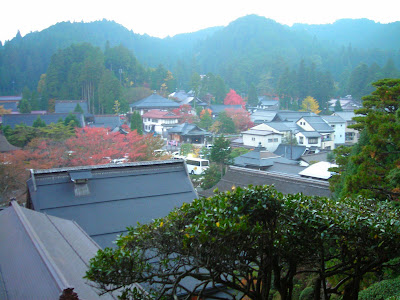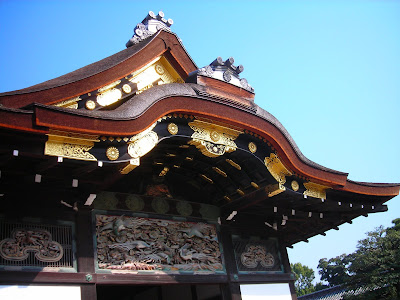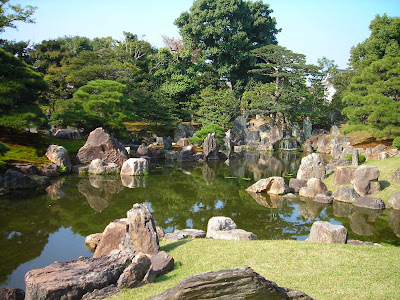My New Life: A Tour
So last month, on the day after my 22nd birthday, I moved to a small town in western Japan. According to the way most Western people think of Japan, it is somewhat to the north, but the Japanese think of Japan as being more horizontal than diagonal, and thus, Tokyo is in the west and Kyoto in the east. At any rate, Numata is a small town deep in the mountains of northern Gunma (a prefecture in Japan). The population is roughly 50,000 people. It has a train station, a department store, a number of good restaurants and a decent bar, a bowling alley, and a karaoke place. When I first came here, it was the middle of August and the heat was stifling, unending, depressing. When you went outside you sweated; if you were outside, your clothes were damp with sweat--and it was like this every day. When it was sunny, at least it wasn't too bad; when the sky was grey and low, heavy with clouds, it was profoundly claustrophobic--and almost unbearable. Under that oppressive white sky, the crumbling buildings and abandoned storefronts of downtown Numata looked a little like my own personal vision of hell.
But even then, it wasn't all bad. The strangeness of the constant sound of cicadas, the remarkable colors of the almost tropical flowers that bloomed along the road to my school, the unexpected beauty of an extraordinary fierce summer thunderstorm, like nothing I had ever seen before.
And things are getting better now. Autumn is coming, and the air is crisp. But things were pretty terrible at first. For the future, I want to remember that.
Anyways, one of the good things about Numata is my apartment. It's very nice to have a space all of my own; it's also a surprisingly nice apartment. It even has a washing machine (no drier, of course), although I think washing my clothes by hand would probably be more effective. My apartment is on the third floor of a very pink apartment building. That's one of the strange things about Japan--the architecture. So much of it seems to straight out of the "Brutalist" school--a better name for a style I've never heard--and yet some of it is just so fucking weird. Apartment buildings? Pink, bright yellow, purple--I've seen it all. The other day I went to a concert for my school in the local "cultural" building. It's this hideous concrete construction, ugly and brooding and 100% Japanese, but the inside was completely green. The walls and ceiling were painted green--over concrete. The carpet was green. The upholstery on the seats was green. The curtain on the stage was probably green, although I can't remember. It was the most bizarre feeling.
Sorry about the digression. In this picture, you can see just how pink my apartment building is. This is the door to my apartment! Number 6.
Once you open that door and venture into my lovely little place, you will first step into the genkan (where you take off your shoes.) This is one feature that almost all Japanese architecture shares--that division of personal and private space. Past the genkan, it's your house; for a long time the genkan was basically the house's front yard. Anyone could wander in. But you couldn't go any further.
Anyways, so you take off your shoes, and step up (the physical separation is very important, I think) into the kitchen. The floors are a dark wood, as they are in my entire apartment (aside from the bathroom.)
This is a view taken from the living, facing the front door. To the left is the door to the bathroom. (It's usually open, as I am afraid of humidity accumulating in there.) On the right you can see my refrigerator, my microwave, and my toaster oven. They are all quite remarkably ancient, and came with the apartment. For some reason, my refrigerator has a "new driver" sticker on it. These are the stickers that people who have just got their license are supposed to put on their car. (The green and yellow thing.) In the states, you might think this is a sign to other drivers to beware. But in Japan, not quite. Apparently, if you commit some sort of traffic violation in the vicinity of or involving one of these cars, the fines can be higher or the penalties more severe.
Beyond the refrigerator, you can see my general kitchen area. This includes my countertop and sink (made of some kind of metal.) And my shelves. You can't really see in this picture, but for some reason, the designers of my apartment decided to place the only shelves in the kitchen on the top of the walls. I mean, they are connected to the ceiling. And they only reach down about a foot. Considering that this apartment's kitchen was almost certainly designed for those grizzled, 4 foot tall Japanese obaachan's I see around all the time, this seems like a design flaw. I can just touch the bottom of them with my fingertips. As for the rest of my kitchen equipment--well, there's bad news and good news. The bad news? There's no oven, just a gas range. There's also no dishwasher or garbage disposal, but that's more common. Very few people in Japan have proper ovens, however. The good news? It's surprisingly spacious, although I need more shelving. Everything seems to work pretty well. The sink is quite large. And my predecessor left me a huge number of various pots, pans, and dishes.
A quick tour through the rest of the apartment...
This is my bathroom. It is basically an airplane bathroom with a shower. The shower does work quite well though--good water pressure, lots of hot water. It also has a bath--it's tiny, but strangely high. I haven't actually taken a bath, although people tell me it is very good in the winter, when it's absolutely freezing. Everything else works pretty well, despite being so tiny, but it's quite a funny thing. It's basically like a pre-fabricated bathroom put into your house--it's all made of plastic, and I think it is seperate from the rest of the apartment. It's very strange. The toilet doesn't flush so good and I have the occasional drainage problem, but other than that it works very well!
Moving on towards the back of the house, we have the "living room." It's not really seperate from the kitchen.
Here we can see my huge closet on the left. I'm not sure why it is in the living room instead of the bedroom type area, but there you are. It's basically just this huge hole in the wall. It doubles for a clothes closet and various supplies closet. Also to the left, out of view, is my washing machine, set back in the wall. On the right you can see my loveseat thing, and also my table, which is called a kotatsu (an electric table that you can heat up during the winter, to keep your feet toasty warm.) It is quite messy as you can see. Beyond the door directly ahead is my bedroom.
This is my bedroom (part of it anyway.) On the floor, you can see my futon--actually quite cozy. As you may notice I have a lot of nice big windows in this room. To the right is a bookshelf and the TV, to the left is a couch and my computer desk/chair. It's quite a nice room, actually. I like it.




